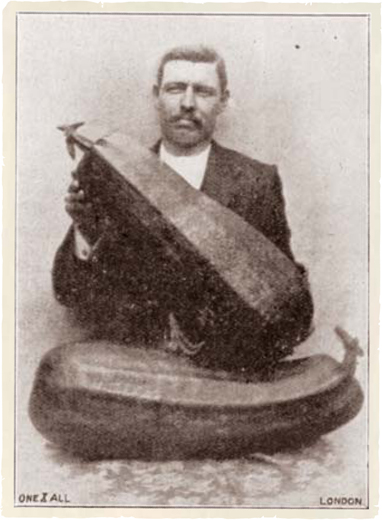 Vegetables
Vegetables 
 Vegetables
Vegetables 
THERE are, doubtless, some few people still remaining who profess that they cannot see beauty in the vegetable quarters of a garden, but the sensible person sees a twofold charm. A splendidly grown bed of Potatoes, or Cabbages, or Onions is as handsome in its totally different way as a bed of Stocks, or Asters, or a row of Sweet Peas, and it has the additional merit of utility. Indeed, it is a necessity, for without fresh vegetables there are not many among our teeming town populations who would be able to live in that perfect health which alone brings happiness. And the better the culture of the several kinds, and the fresher they can be served upon the table after gathering, the higher will be their nutritive value and the richer will be their flavour. Gradually, but nevertheless surely, the nation is coming to see the full value of vegetables. Hitherto they have been consumed largely as a change from meat, or as an addition thereto, adding to its palatability and its digestibility. But nowadays it is known that the ordinary vegetables of our gardens contain all the essential foods, and that it is not only possible but exceedingly easy for life, and vigorous life too, to be sustained on them alone. Bulk for bulk the meat may show the higher nutritive value, but the foods are in the vegetables, and, properly cooked, they will respond to all the demands that may be made upon them by the human machine. As a matter of fact, there is not the smallest room for doubt that the nation would be for healthier if it consumed more vegetables and less meat.
 Asparagus
Asparagus 
It is not so very many years ago when it was considered that this was a vegetable suitable only for the extensive gardens of the affluent, but it is now recognised as a plant for all gardens in which space can possibly be found for the beds. There is not the slightest need to have these raised above the ordinary level, as was invariably the custom a while back, for if the ground is deeply and thoroughly dug, vegetable refuse and manure worked into the second spit, Asparagus will thrive splendidly, and with annual attention the beds will remain profitable for an unlimited period. There are two methods by which a start can be made, and each grower must choose the one which is the more convenient to himself. After the preparation of the soil in the early months of the year, the position chosen should be allowed to settle down a little, and one or two-year-old plants purchased expressly for the purpose can be planted 15 in. apart in rows 3 ft. asunder; the best time for this work is towards the end of March or in April, when active growth has just made a start after the winter’s rest. By this means we shall have a bed in bearing in the second or third year subsequently to planting, according to the age of the original stock.
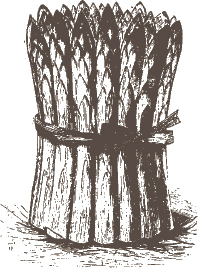
 Globe Artichokes
Globe Artichokes 
These are not nearly as popular at home as they are in France, and it cannot be claimed for them that they are plants for the small garden, as they take up a considerable amount of space which might be more profitably devoted to other crops. They, however, provide a welcome change vegetable for those who can afford the time to eat them. The most suitable soil is a deep, rich, light loam, and propagation can be readily effected from seeds sown in stations 2 ft. asunder in March; this distance will suffice for the first year, but in the second each alternate plant must be removed, as a distance of 4 ft. is necessary to successful results. Some finely sifted coal-ashes ought to be drawn up to each plant, and mulchings with manure are most desirable. In autumn the plants must be trimmed up and have coal ashes heaped round and over the crowns. After three years the plants become unprofitable, and those who require a constant supply should therefore do a little propagation every alternate season, or each season, if desired. The summer growths are sometimes blanched by wrapping straw bands round them, and when these are used it is under the name of Chards; the process of blanching will take about six weeks.
 Carrot
Carrot 
Among tap-rooted vegetables this ranks in importance with, or even higher than, the Parsnip, and it is essentially a crop upon which it is impossible to devote too much care and attention. The most important of all cultural points to bear in mind is that Carrots must never be grown on land which has just had an application of natural manure, as this almost invariably leads to the production of wasteful, fanged, and forked roots.
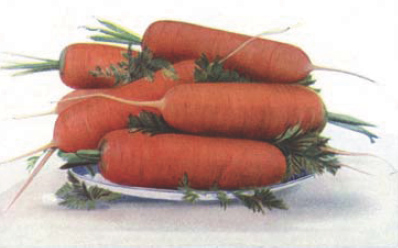
In sowing the seeds, the grower who drops clusters of three or four at distances varying a little with the habit of the variety is wise, for he not only saves seeds and labour in thinning, but considerably reduces the danger from attacks of the dreaded Carrot fly. The drills should be about 1 in. in depth and 10 in. to 12 in. apart, according to the variety. With a view to circumventing the fly, the grower should commence to thin out immediately the seedlings have pushed through the surface, and the soil should always be re-firmed to the plants which remain. Sowing should be done successively through March and April, and a further sowing should always be made in July to yield fresh, sweet, small roots in the autumn and early winter, when it is certain that they will be immensely appreciated. Those who desire to have specially excellent roots for exhibition, and have not a soil that is naturally favourable, adopt the practice of boring holes 2 ft. or so deep, filling these with a compost of loam, leaf mould, and sand, and sowing three seeds in the top of each; when the seedlings show through, and it can be seen which will make the finest plant, the others are removed.
The general crop should be lifted in October or November, and the roots stored in a cellar or shed in alternate layers of fine, dry soil or sand and roots. Here they will keep in splendid condition, and can be used as required.
 Kohl Rabi
Kohl Rabi 
As far as British gardens are concerned this is an unimportant crop, and the amount of space devoted to it should always be strictly limited. It is, however, a very palatable vegetable, and sometimes comes in exceedingly valuable, especially in the event of an unforeseen break in the succession of Turnips. The ground must be deep and in good heart, but over-richness induced by the excessive use of natural manures must be strenuously avoided. The drills should be drawn 15 in. asunder and ½ in. deep, and the seedlings thinned until they eventually stand 15 in. or 18 in. apart, for the plants to grow to perfection. There are purple and green varieties, both of which are of equal excellence. Needless to say, Kohl Rabi is a cattle food of the greatest value.
 Leek
Leek 
This relative of the Onion is a plant that is most seriously neglected in the smaller gardens of this country. It is actually one of the hardiest vegetables we have, and a constant supply during the winter months, when fresh produce is never too abundant, should be aimed at by all good cultivators. It is a comparatively easy plant to grow, provided that a deep soil which has been generously enriched with natural manure is at command. The plant demands a long season of growth, and seeds should be thinly sown in a box of light soil in a warm frame in February, and a second sowing made on a warm border in the following month. The seedlings must be thinned out and pricked off into nursery beds according to necessity, as it is imperative to success that they shall never become crowded and drawn, and, further, that they shall never cease to grow, as it appears to be impossible to persuade them to grow out of a check which they have received in the young state.
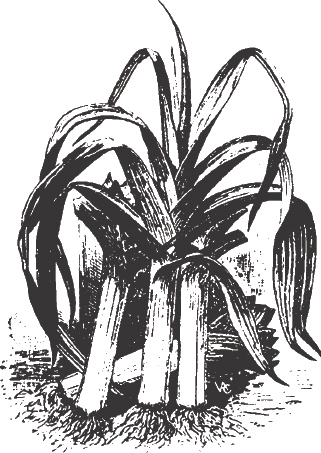
Prior to planting, it is necessary to take into close consideration the principal object of culture. If the plants are particularly wanted for exhibition, trenches, similar to those for Celery, will have to be cut and have manure placed in and soil above that before planting; but if the plants are wanted exclusively for the home, it will suffice to bore holes 10 in. deep with a blunt-ended dibber, or a broom-handle, drop in the plants, fill the hole with water to settle down the soil, and leave them to grow and blanch themselves, which they will do in a perfectly satisfactory manner.
 Parsley
Parsley 
This is one of the most important of all the garnishing herbs, and no efforts must be spared to maintain a constant supply of the finest leaves. It is as necessary to prepare the ground well for this crop as it is for Potatoes or Onions, and unless this is done the measure of success will never be full. Cultivate deeply and thoroughly, and incorporate a fair dressing of the finest procurable manure, putting the bulk of it in the second spit or between the top and lower layers of soil. Draw the drills 3/4 in. deep, and sow the seeds very thinly in succession from March onwards. Directly the seedlings are large enough to handle commence thinning, and continue gradually until the plants stand at least 9 in. asunder for development.
 Parsnip
Parsnip 
As a winter vegetable there are few more popular than this, notwithstanding the fact that its nutritive value is comparatively low, and is commonly still further reduced by the almost universal practice of cutting the root into slices prior to cooking, instead of boiling it whole and thus retaining its full flavour. As far as the preparation of the soil and the sowing of the seeds are concerned, the procedure with this crop is precisely the same as that for Carrots, but there are slight differences in management and detail. The rows for Parsnips should never be closer than 15 in., and thinning must always be done to 10 in. asunder. The times of sowing the seeds differ also, as the present crop is perfectly hardy, and, if desired, seeds may be sown in the autumn; but, as a rule, sowing at the earliest possible moment in the spring, when the weather and the soil are favourable, will bring about quite satisfactory results.
 Salsafy and Scorzonera
Salsafy and Scorzonera 
These tap-rooted crops are not of really substantial value, but as change vegetables for use during the winter they might well be more extensively cultivated. The method of preparation of the soil and management is identically the same as for Carrots, but the seeds should be sown in drill 1 ft. apart at the beginning of April, and the plants must be thinned to 8 in. asunder in the rows.
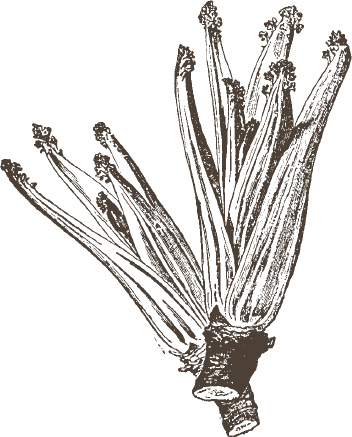
 Seakale
Seakale 
This is a most valuable and palatable vegetable, that is more appreciated when produced, so to speak, out of season than when grown normally in the garden. Although plants can be raised from seeds, the system is not recommended for general adoption, as they are some time before they are of value, and increase is so readily effected by the thong- or whip-like portions of the roots after once a stock has been procured. The soil must be deep and good, and forcing is simple if pots or boxes surrounded by manure are used; or three-year-old crowns can be purchased or raised, and these can be lifted and placed in boxes with a little shallow soil in gentle heat, and they will soon develop produce of excellent quality.
 Spinach
Spinach 
This green vegetable ought to be far more extensively cultivated, not on account of its high nutritive value, but because it exercises such an excellent effect upon the blood – as a matter of fact, it is one of the finest purifiers that we can have. It is sometimes thought that Spinach will grow in any position or soil, but it is only when the land is deeply worked and judiciously manured and the plants are thinned out to at least 6 and preferably 8 in. apart in the rows, that the finest leaves are produced. Seeds should be thinly sown in drills an inch deep and 12 in. asunder successively from the middle of February until the middle of August, according to requirements. Poverty of the soil and closeness of the plants leads on to bolting, which causes such trouble in the culture of this crop. Early Giant Thick-leaved is a grand variety for general use.
 Vegetable Marrow
Vegetable Marrow 
Vegetable Marrows are very popular fruit-bearing plants, and they are fully worthy of all the attention that can be bestowed upon them. Their constitution is such that no frost can be withstood, and sowing should therefore be made in frames in March or April, and the plants grown steadily forward in small pots until the end of May, when they are planted out in deep, rich soil. Or seeds may be sown where the plants are to grow at the end of May or early in June, and they will crop splendidly, provided that they are allowed an abundance of space and have water as necessary. For this purpose the Bush varieties are invaluable, as they do not occupy much ground, and fruit earlier than those of rambling habit. For general purpose the Long Green and Long White are admirable, but the Green and White Bush must not be overlooked.
